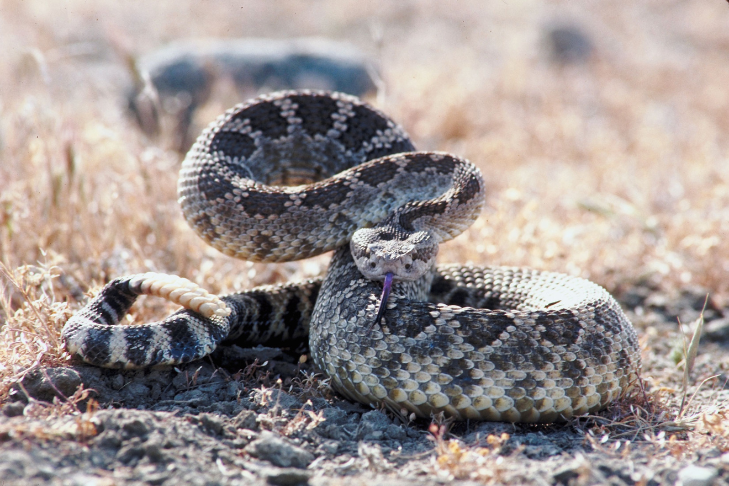What to Do if Your Dog Encounters a Rattlesnake

With summer in full swing, many of us are enjoying outdoor adventures with our furry friends. Unfortunately, along with the sunshine and warmer weather comes a potential danger often overlooked by pet parents: rattlesnakes. These venomous creatures are active during the warmer months and pose a significant risk to our pets, especially dogs. Encounters with pets are not uncommon, so it's extremely important to understand the risks, how to stay safe during rattlesnake season, and what to do if you come across one.
When is Rattlesnake Season?
Rattlesnake season typically begins in early spring and lasts through late fall. The exact timing can vary depending on the region, but generally, rattlesnakes become more active when temperatures rise, usually between April and October. During this period, snakes emerge from hibernation and are more likely to be encountered while hiking, walking, or playing in outdoor areas. Since rattlesnakes are cold-blooded, they can’t regulate their body temperature on their own, so they seek out warm places.
Where Are Rattlesnakes Found in the U.S.?
Rattlesnakes are prevalent in various parts of the United States, with them being most popular in the southwestern states, including Arizona, California, New Mexico, Oklahoma, and Texas. They are also common in the southeastern states like Florida, North Carolina, South Carolina, and can be found as far north as the Great Plains and the Midwest. While they prefer dry, rocky environments, rattlesnakes can also inhabit grasslands, forests, and even suburban areas. In the United States, about 38.9 million homes have a cat, and 46.3 million have a dog. If you live in any region with rattlesnakes, then it’s important to be prepared for anything.
Common Areas for Dog and Rattlesnake Encounters
Encounters between dogs and rattlesnakes are most common in areas where these snakes naturally thrive, including:
- Hiking Trails: Trails that wind through rocky or grassy areas are prime locations for rattlesnake activity.
- Suburban Yards: Homes near natural rattlesnake habitats might occasionally have snakes wander into their yards.
- Rural Areas: Farms and ranches often provide ideal environments for rattlesnakes, increasing the risk for pets living in these areas.
- Parks and Open Spaces: Parks located in or near rattlesnake habitats can be hotspots for encounters, especially during warm months.
What to Do If You Encounter a Rattlesnake with Your Dog
1. Stay Calm and Keep Your Distance: Rattlesnakes usually try to avoid confrontation. If you spot one, calmly back away and maintain a safe distance (at least 10 feet).
2. Control Your Pet: Keep your dog on a leash to prevent it from approaching the snake. If your dog is off-leash, call it back to you immediately.
3. Do Not Agitate the Snake: Sudden movements or attempts to scare the snake away could provoke an attack.
Preventing Rattlesnake Encounters and Bites
Preventing encounters and bites involves a combination of awareness, training, and precautionary measures:
- Stay on Designated Trails: When hiking, stick to frequently trafficked paths and avoid tall grass, underbrush, and rocky areas where rattlesnakes may hide.
- Use a Leash: Keeping your dog on a leash allows you to maintain control and prevents them from wandering into dangerous areas.
- Clear Yard Debris: Remove piles of rocks, wood, and other debris from your yard to prevent snakes from using them as hiding spots.
- Install a Fence: A snake-proof fence around your property can help keep rattlesnakes out of your yard.
What to Do if Your Pet is Bitten by a Rattlesnake
- Stay Calm and Seek Immediate Vet Care: Time is critical. Get your pet to a veterinarian as quickly as possible.
- Limit Movement: Try to keep your pet as still as possible to slow the spread of venom. Carry your pet if you can.
- Avoid Home Remedies: Do not attempt to suck out venom or apply ice or a tourniquet. These methods are ineffective and can cause more harm than good.
- Keep the Bite Area Lower Than the Heart: If possible, keep the bite area below heart level to slow venom absorption.
- Call Ahead: Call the vet clinic ahead of time to inform them of the situation so they can prepare for your arrival.
The Effects of Rattlesnake Venom on Pets
Rattlesnake venom is highly toxic and can cause severe reactions in pets, leading to symptoms such as:
- Swelling and Pain: The bite area typically becomes swollen and extremely painful.
- Tissue Damage: Venom can cause necrosis or tissue damage around the bite area.
- Bleeding and Bruising: The venom disrupts blood clotting, leading to excessive bleeding and bruising.
- Difficulty Breathing: Swelling can impair respiratory function, making it difficult for pets to breathe.
- Shock: Severe amounts of venom can cause shock, requiring immediate medical attention.
Rattlesnakes are a natural part of our environment, and while we need to take precautions to protect our pets, it's also important to respect their role in the ecosystem. By learning about their habitats and behaviors, we can coexist with these creatures and reduce the risk of encounters.
Interested in learning more about pet safety?
5 Things You Should Know Before Letting Your Dog Drink from a Public Water Bowl



